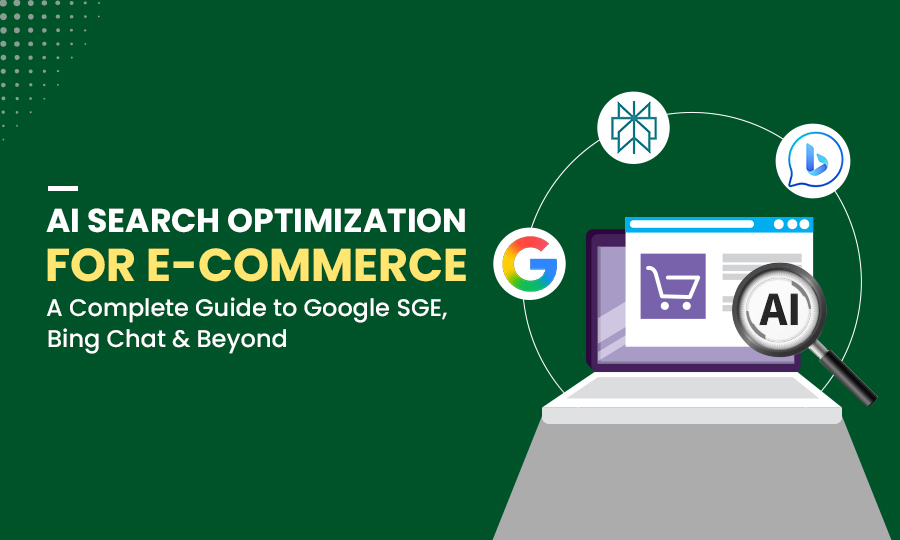The digital shopping landscape has transformed dramatically with the emergence of sophisticated AI search engines like Google’s Search Generative Experience (SGE) and Bing Chat. These platforms have revolutionized how customers discover products, making AI search optimization essential for e-commerce success. Unlike traditional SEO, AI engines understand context and intent and deliver personalized search results that match individual shopping behaviors.
The global e-commerce market is projected to surpass US$6.86 trillion by 2025, growing at a steady CAGR of around 8–9%, with Asia-Pacific holding nearly half of the market share. In this competitive edge, only search engine optimization strategies are not enough; you need to optimize for AI search results. Almost 67% of marketers believe AI strongly increases their SEO initiatives.
In this comprehensive guide, you will learn how to do keyword research for SGE, Bing, and maintain a website for AI search results, and all the necessary search engine optimization strategies for AI search results.
What Is AI Search Optimization For An E-Commerce Website?
The process of optimizing online stores for AI-driven search engine results pages (SERPs) is known as AI search engine optimization for e-commerce websites. It focuses on responding to developing search trends, recognizing conversational search queries, and using smart SEO content creation. When AI-powered search tools produce results, the intention is to increase the visibility of product pages and content to help consumers find and select products more quickly.
Traditional SEO will give your online presence an extra boost on only search engines. But when you optimize content and the website for AI search engines, it will show your website when someone searches on AI-powered search engines like Google SGE, Bing Chat, Perplexity AI, You.com, and ChatGPT with browsing. Generative AI tools have replaced traditional search engines for product and service recommendations by 58% of consumers, which is a big jump from 2023, when only 25% of consumers used Generative AI tools.
Before we delve into the details of AI SEO strategies for an e-commerce website, it is essential to understand the key terms associated with AI search optimization. It will help you understand the core concept better if you know the exact meaning of terms.
- Generative AI-When AI doesn’t just get information, it creates new content like text, images, and product summaries. This technology is able to analyze patterns and trends in existing data to generate original content. It has the potential to revolutionize industries such as marketing, journalism, and entertainment.
Example: Google SGE produces a product comparison list for “best budget smartphones.” - Generative Engine Optimization (GEO)–The process of optimizing websites for AI-generated answers in search results. This involves creating content that is specifically intended to be picked up and featured by AI algorithms, increasing awareness and traffic to the website. It’s like you develop content and websites for AI engines to pick.
Example: Adding FAQs so Bing Chat includes your store in its product recommendation summary. - AI-Powered Search Engines: AI-based conversational and summarized search platforms.
Example: Google SGE, Bing Chat, Perplexity AI, You.com. - AI Search Results-Answers or product lists generated by AI rather than just showing blue links.
Example: Asking for “top running shoes under $100” → SGE shows a carousel of shoes with ratings.
Why Ecommerce Site Optimize for AI Search Engines (SGE, Bing Chat, etc.)?
Here you can get an in-depth knowledge of how an AI search engine shows your products. So that you have an idea of why you need to optimize your website for AI-driven search tools.
What Shopping Features Does Google SGE Offer?
- Google SGE = a feature inside Google Search powered by generative AI.
- Google AI = Google’s entire AI ecosystem (models, products, research, and features like SGE).
- Google SGE (Search Generative Experience)
- Google Search has an experimental feature that improves search results using generative AI.
- SGE (Search Generative Experience) is now in over 120 new countries and territories as of November 2023. Google officially states that besides the USA, India, and Japan, many countries like Mexico, Brazil, South Korea, Indonesia, Nigeria, Kenya, South Africa, etc. are included.
- One specific shopping feature (personalized style recommendations via swiping/thumbs up or down) is confirmed for U.S. shoppers (on mobile browsers and the Google app) currently.
- SGE displays AI-generated snapshots, product summaries, comparison tables, and conversational follow-ups directly in search results.
- Example: If you search “best laptops for students under $700,” SGE might show a short AI-written answer, a product carousel, and a comparison table.
- It is a component of Google Search Labs, which is still undergoing testing in several nations.
- Google AI Overviews
- This is Google’s overall artificial intelligence division/branding (similar to “Google Cloud” or “Google Ads”).
- It involves research projects, AI models (like PaLM and Gemini), and products (Bard, now Gemini chatbot, Vertex AI, Duet AI, etc.).
- So “Google AI” is much broader—it comprises all AI technologies Google creates, not just search.
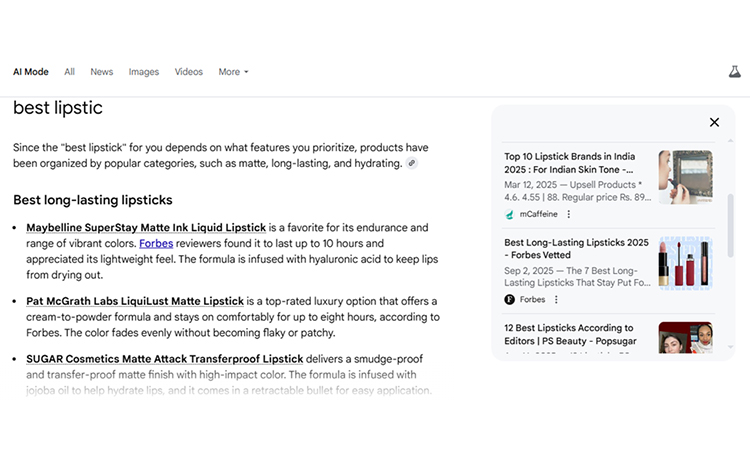
- When you search a shopping query (say, “best lipstick under $100” or “best 4K TVs”), SGE tends to generate an AI overview that includes summaries/AI-powered snapshots of products. A carousel of product options with pictures, prices, and occasionally ratings or reviews may be included in these summaries.
- SGE may display comparison data alongside carousels, such as a table or side-by-side summary of product attributes (specs, pros/cons), which aids users in rapidly separating options. For example, Product A has feature X, Product B is cheaper but has fewer specs, etc.
- SGE also likes to highlight sales and discounts and let customers know if an item is in store, how much it costs to ship, and whether the current sale price is lower than the normal price. These show people what they can do (buy now vs. wait).
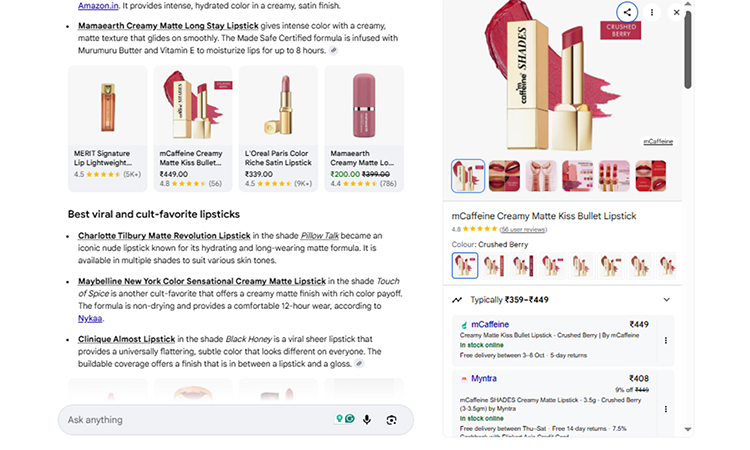
- Reviews/ratings: For many shopping carousels or product summaries, user ratings (stars), peer reviews, or summarized feedback are shown. These help build trust and guide decision-making.
- Interactive/personalized shopping: In some markets, Google has begun to include style/preference recommendations (e.g., for “apparel, shoes, accessories”) based on user feedback (thumbs up/down, etc.).
What is are Bing Chat + Shopping Feature?
You can write any product you want in the Bing search bar. To get better results, you can choose the “shopping” mode and get detailed products with various filters like company and price, and so on. Like this-
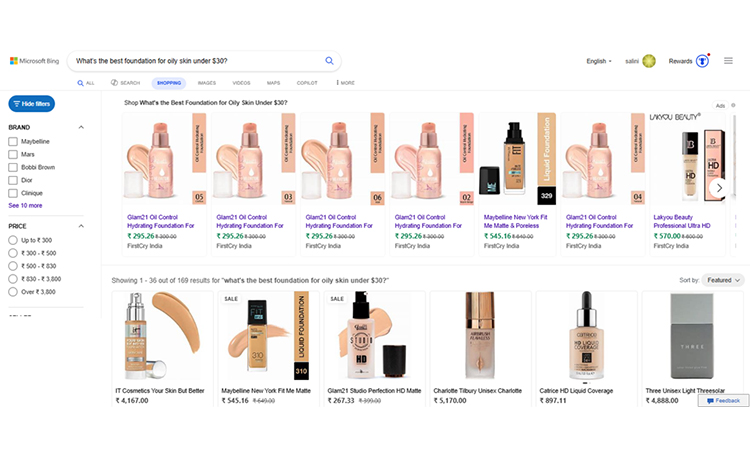
Microsoft Copilot in Bing, which is now a part of Bing Chat, uses conversational AI to help users with their questions. It can summarize results, compare products, display images, integrate shopping tools, and review summaries in addition to returning standard search links.
Then you can write in Copilot what you want. Then it will give a guide with links to your desired products and their website. Therefore, optimizing content for AI search engines will improve your brand visibility and recognition.
Bing Chat might respond with:
- A summary: “Here are some recommended foundations under $30 that work well for oily skin — lightweight formulas, oil control, and long wear.”
- A comparison table or cards showing 3-5 options, each with:
- Product name and image
- Price
- Rating or review summary (e.g. “4.5★ from 1,000+ reviews”)
- Key features (“matte finish, oil-free, SPF included, etc.”)
- Links to retailers or product pages
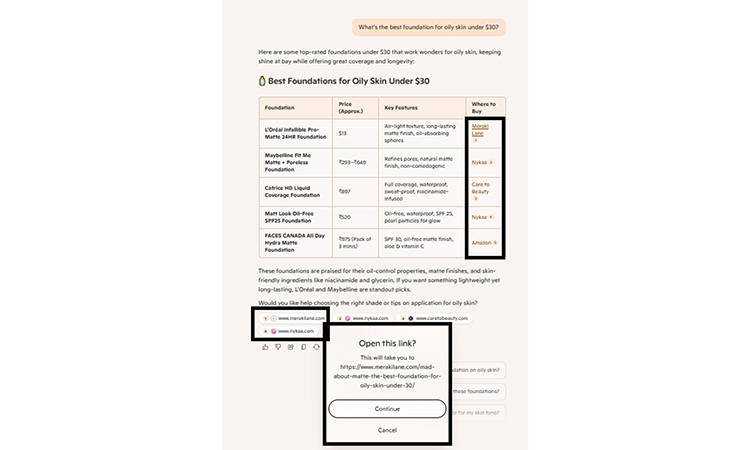
It also supports “buying guides” and comparison charts. For example, when users search for “best eyeshadows” or “best laptop,” Bing generates an AI-made guide with comparisons among relevant products. This feature helps users make informed purchasing decisions based on reviews and comparisons.
Why It’s Good & Why E-Commerce Sites Need to Optimize for Bing Chat?

- Increased website visibility: People may decide to buy your product right away from the comparison table, buying guide, or carousel that shows up in Bing Chat without even clicking further. That gives your store exposure.
- Enhanced trust and engagement: Your users can choose with more confidence when they see review summaries, images, and feature comparisons. That tends to improve conversion.
- Competitive advantage: Many e-commerce sites are still optimized only for classic search. Your site will get hits in the next-generation search behavior if it is optimized for Bing Chat.
- Shopping intent capture: Moreover, users looking for products often ask in conversational form (“which foundation” or “foundation for oily skin”). If your site is ready (feeds, schema, clean product info), it can pop up in response to those queries.
ChatGPT for E-Commerce: Smarter Shopping Experiences
With the help of browsing or plugins, ChatGPT can function as a customized shopping assistant. Users may ask things like “What’s the best running shoe under $100?” or “Show me laptops with good battery life for students. ChatGPT then compares features, summarizes products, and even provides links to retailers.
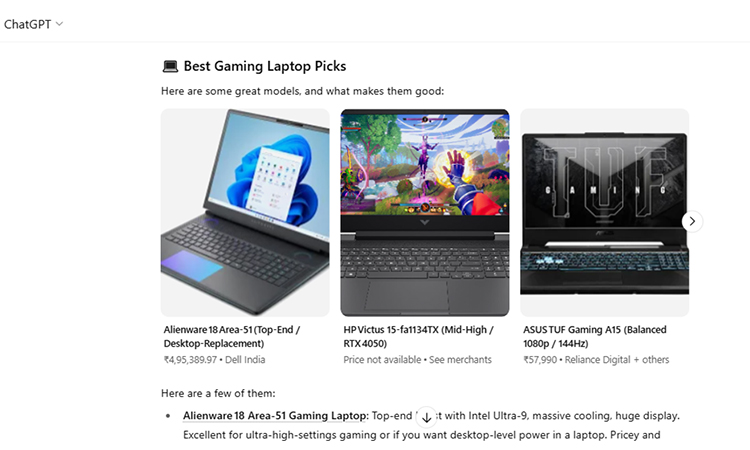
Why Should E-Commerce Sites Optimize for ChatGPT?
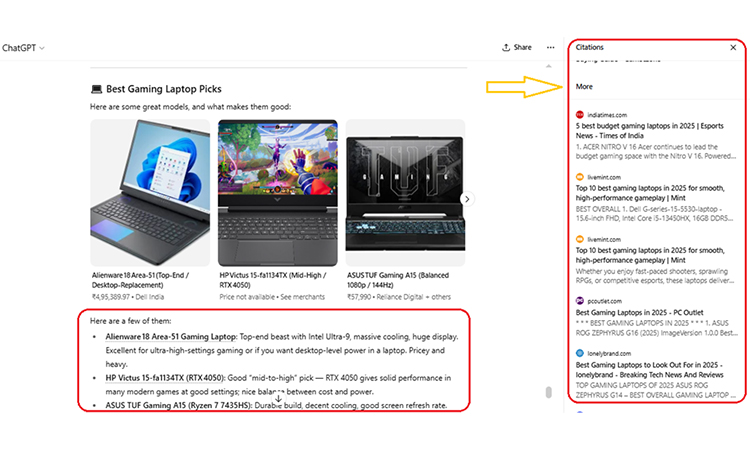
- Content Optimization: E-commerce sites need to structure product pages with clear descriptions, FAQs, and schema markup so ChatGPT can pull accurate data.
- Conversational Queries: Question-based optimization of content to match natural, conversational searches improves the chances of showing up in ChatGPT responses because people shop by asking questions.
- Personalized Search Results: ChatGPT adjusts suggestions based on what the user wants, which means that well-suited ecommerce stores can show up for very specific requirements (like price, features, and reviews).
- AI SEO Advantage: Unlike traditional SEO, ChatGPT doesn’t just show links—it recommends products directly. If you optimize your content, it brings your brand closer to people who are ready to buy.
AI-Powered Shopping with Perplexity Pro: Why It Matters for E-Commerce
People who are Pro users of Perplexity in the U.S. see product cards with pictures, prices, reviews, and specifications when they ask about shopping. Some of these processes may also work outside of the U.S., but the “Buy With Pro” checkout system is only feasible in the U.S.
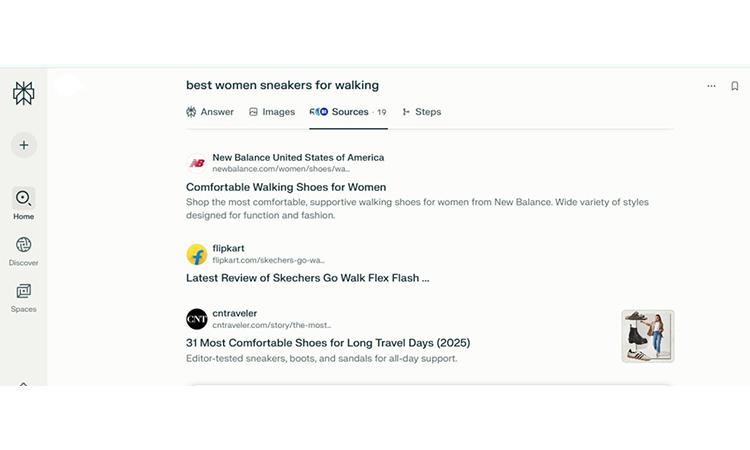
Unique Features of Perplexity Pro:
- Cited Sources: Perplexity displays references with links, in contrast to the majority of AI search engines. It will allow customers to confirm product details up front.
- Web Results in Real Time: It retrieves the most recent information from many sources, so product details like availability, reviews, and sales are current.
- Pro Mode Personalization: Furthermore, it will give deeper context and more specific answers based on user preferences. It will automatically improve the shopping journey, so you can bring more organic traffic to your website through AI-generated outputs.
How to do E-commerce Sites Keyword Research for AI Search Engines (SGE, Bing Chat, etc.)?
- Start With the Big Picture: Why AI Changes Keyword Research
Bing Chat, Perplexity, and Google’s generative results/SGE are examples of AI-driven search that frequently offer summaries, comparisons, and answer boxes rather than a lengthy list of links. So, you should focus on question-style queries, quick answers, and comparison terms in addition to traditional head keywords. This shift indicates your keyword research must identify search intent (conversational, commercial, or local) and not depend on old “head-term” volume.
- Build an Intent-First Keyword Map (search queries / relevant keywords)
How to structure it:
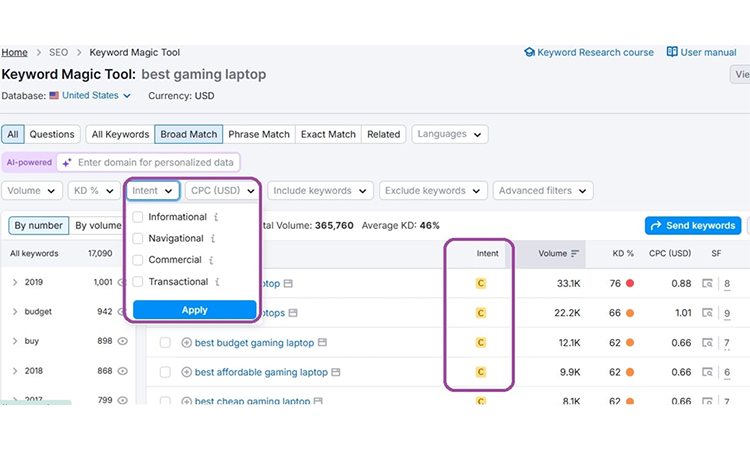
- Columns: seed keyword → Search Intent (informational/commercial/transactional) → conversational variants (questions) → search volume → keyword difficulty → priority score.
- Prioritize product comparisons, “best X for Y,” “alternatives to [brand],” “is [product] worth it?” and local “near me” queries.
- Use customer data (support transcripts, on-site search logs) to capture real search queries customers actually use.
Tip: AI search engines prefer long-tail keywords, natural language—include 3–7+ word queries and question forms.
SEMrush Step-by-Step Keyword Research Workflow (search volume/keyword difficulty/data analysis)
- Sign in to the Semrush keyword research tool.
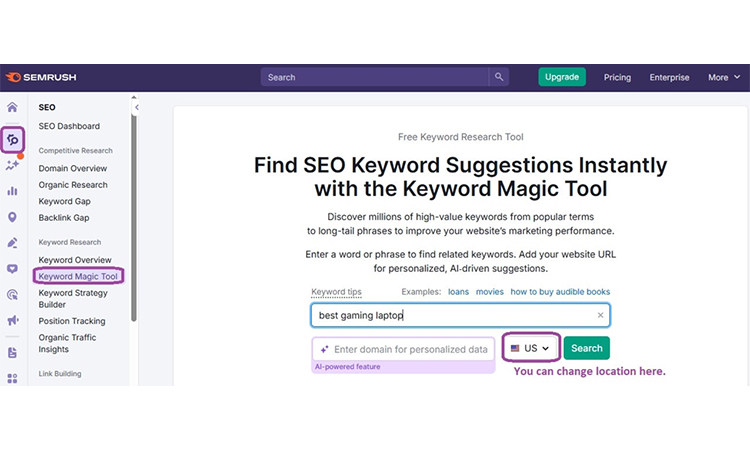
- Then go to the magic keyword tool, put your main keywords in the search bar.
- After that, you get this in-depth list of that particular keyword-
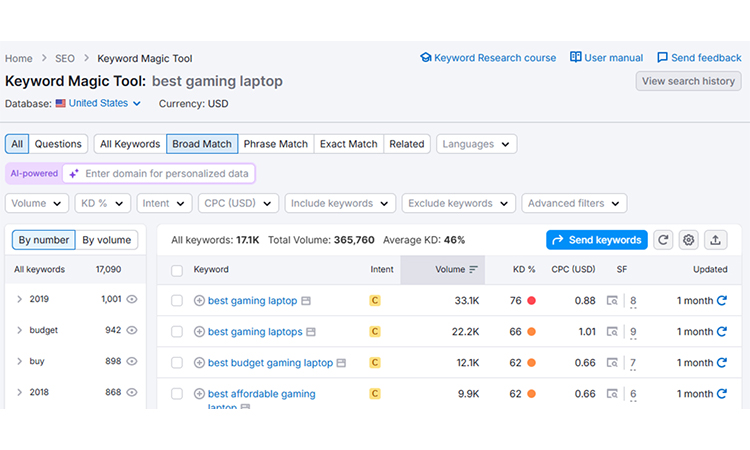
You can follow these tables to create your relevant keyword group.
| Metric | Definition | How to Read It | Tips to Choose |
| Search Volume (SV) | Average number of times a keyword is searched per month. | High SV = more traffic potential, but often more competition. | Balance volume vs. intent. Don’t chase only big numbers—long-tail queries with lower SV often convert better in e-commerce. |
| Keyword Difficulty (KD) | A score (0–100) estimating how hard it is to rank for a keyword. | Low KD = easier to rank. High KD = strong competition, usually dominated by big brands. | For new/medium sites, target KD < 40. For authority sites, you can go after KD 50+. |
| CPC (Cost Per Click) | The average cost advertisers pay per click in Google Ads for this keyword. | Higher CPC = keyword is commercially valuable and has strong buying intent. | Prioritize high CPC + medium SV terms for e-commerce because they indicate purchase-ready customers. |
| SF (SERP Features) | Special results that appear on search results pages (e.g., Featured Snippets, FAQs, Reviews, Shopping Ads). | If a keyword triggers SF, AI Overviews / Bing Chat may also highlight it. | Choose keywords with rich SERP features (Product snippets, Reviews, FAQs). Add schema markup to increase chances of being shown. |
- Go to the “Question” tab and get a question keyword-
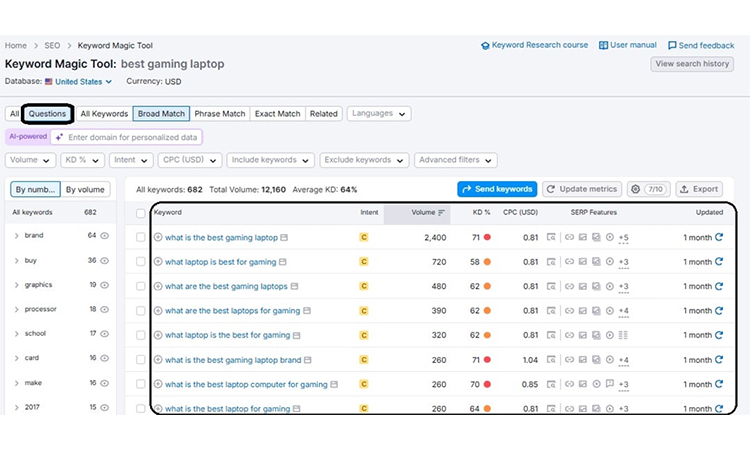
Use AI Tools for Ideation & Question Mining (AI algorithms / AI-powered tools)
- You can use chatbots/AI search (ChatGPT, Gemini, Perplexity, Copilot) to generate conversational variations and buyer questions. These models are excellent at surfacing how people ask about products. Semrush recommends chatbots as free ideation tools.
- Example prompt: “List 50 natural-language questions customers ask when searching ‘best foundation for oily skin.'”
- Feed those questions into Keyword Magic / Topic Research to get volumes and KD.
Map Keywords to E-commerce Page Types (relevant keywords / SEO strategies)
- Product Pages: transactional long-tails and brand + model queries.
- Category Pages: broad commercial keywords and short comparison phrases.
- Comparison Pages & “Best X” Guides: high value for AI Overviews (AI loves lists & comparisons).
- FAQ & Q/A Blocks: short answers to conversational queries (very important for voice & chat).
- Blog/How-To: informational intent (use for discovery & to feed internal linking).
Tool Recommendations — Best Research Tools for Different AI Platforms
- For Bing Chat / Microsoft ecosystem
- Primary: Bing Webmaster Tools, Microsoft Ads Keyword Planner (for query ideas).
- Supporting: SEMrush / Ahrefs for competitor data; use Perplexity / Copilot to craft conversational variations.
- For Perplexity / Research-style AI
- Primary ideation: Perplexity AI itself (great for questions & source lists). Use it to find how sources phrase answers.
- For ChatGPT / Gemini
- Primary ideation/tooling: ChatGPT (with browsing/plugins) or Gemini for generating conversational queries and content drafts. Use these to expand question lists, then validate in SEMrush/Keyword Planner.
- Content optimization stack
- Surfer SEO + Jasper/ChatGPT for AI-assisted content that respects SEO guidelines.
- Free quick tools
- Google Trends, Keyword Surfer (browser extension), Google Keyword Planner, Chatbots for ideation.
What is E-commerce Content Optimization for AI Search Engines?
Content creation is very important for an e-commerce website. You can follow the following guidance and design your E-commerce Site content for AI Search Engines (SGE, Bing Chat, etc.)
Learn How AI Search Algorithms Work in E-commerce
Advanced AI engines use machine learning algorithms and natural language processing to interpret customer inquiries rather than traditional search systems. When someone searches for “comfortable running shoes for flat feet,” artificial intelligence (AI) search engines not just match keywords; they understand user intent and suggest products based on user reviews, foot type, and comfort features. The goal is to provide highly personalized recommendations for the user and attract relevant traffic.
Your product pages should communicate with AI systems and your target audience in the same language. Many times, AI overviews show product details, prices, and important features before people even click through to your website.
Product Page Content Optimization Strategies
Your product pages are the basis of e-commerce AI SEO. So, you need to place valuable content in strategic locations where AI crawlers can easily access and interpret information:
- Product Titles: You can generate descriptive, natural-language titles that answer natural language queries. Instead of “Men’s Blue Jeans Size 32,” use “Men’s Comfortable Stretch Blue Jeans—Perfect Fit Size 32.”
- Product Descriptions: You will be able to write thorough descriptions that cover client inquiries. Advanced artificial intelligence (AI) search engines like content that is detailed, informative, and gives useful information about a product’s benefits, uses, and specs.
- FAQ Sections: Then you may incorporate frequently asked questions directly on product pages. This strategy for optimizing content helps AI engines figure out what problems customers usually have and put your products in the right place for those problems.
Category and Collection Pages
Then you should transform category pages from simple product listings into information-rich resources. Give customers information that helps them make decisions, like buying guides, comparison charts, and educational content. This approach raises search visibility and gives AI-powered search engines the complete data they need. This will improve your AI SEO processes.
Develop AI-Optimized Content That Converts to Leads
Contemporary content creation for e-commerce requires a conversational approach. You can embrace natural language content creation. Then you need to understand search engine algorithms to create better content for AI platforms. Make the product descriptions sound like you’re helping a friend pick out the right thing. This organic style enhances the visibility of your content in AI overviews. It also improves the overall user experience and engagement on your website.
Work on optimizing content by:
- Answering specific customer pain points
- You need to use precise language that paints a clear picture.
- Incorporate size reviews, care instructions, and usage tips.
- Integrate user-generated content like customer reviews and testimonials.
Write AI-Generated Content Strategically
E-commerce brands successfully combine human knowledge with AI efficiency, even though AI-generated content can speed up content production. You can use AI-powered tools for early content drafts, then enhance them with unique selling points, brand voice, and specific product knowledge that only humans can provide.
Human oversight guarantees authenticity and brand consistency that connects to your target audience, even though generative AI tools are excellent at producing product variations, meta descriptions, and category descriptions.
Quick Prompt Bank
You can copy this prompt and paste it into any AI tools like ChatGPT and Perplexity. And then you get the best content creation for your website.
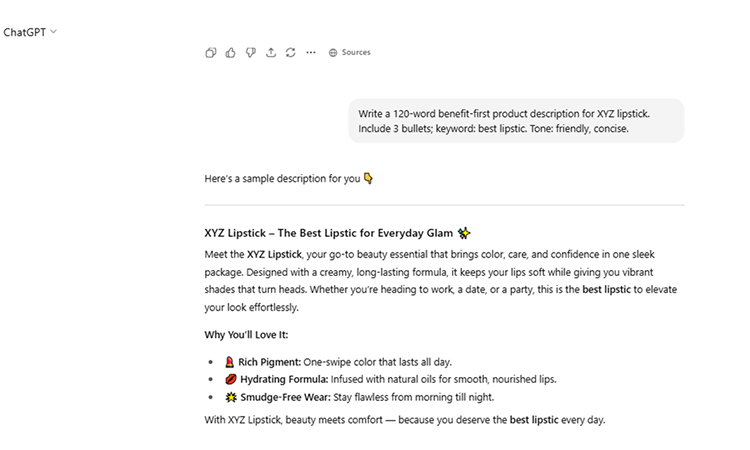
- Product description:
“Write a 120-word benefit-first product description for [name]. Include 3 bullets; keyword: [kw]. Tone: friendly, concise.” - FAQ:
“Create 8 conversational Q&A for ‘shipping & returns for [product].'” - Meta:
“Provide 5 meta title + meta description pairs for [page], targeting [keyword].” - JSON-LD:
“Generate JSON-LD product schema for [name], price [x], currency INR, availability InStock, rating 4.5, url [link].” - Internal links:
“List 6 relevant internal pages to link from [product page] with anchor text suggestions.”
How To Create Voice Search Content for An E-Commerce Website’s visibility?
- Understand the Target Audience—Voice questions are more in-depth and speak to you. People you want to reach might not type “running shoes online” but instead ask, “Where can I buy cheap running shoes near me?” When you know how your customers talk about your goods, you can make sure that your content fits with what they mean.
- Use Conversational AI SEO Processes—Restructure product pages, FAQs, and blogs to answer full questions. Example: Instead of only writing “best laptops 2025,” include Q&A-style content like “What is the best laptop for gaming under $1000?” This improves alignment with search algorithms that handle natural speech.
- Focus on Local and Personalized Voice Search Queries—Many voice searches are local (e.g., “buy headphones near me”). It’s necessary to add schema markup for store hours, addresses, and products that are in stock so that AI-driven and AI-powered search results can find your store.
- Optimize for Mobile and AI Search Engines— Most people use voice searches on their phones, so make sure your pages load quickly and have clear calls to action and well-structured content. You can get smart assistants like Siri, Alexa, and Google Assistant to show your site more often if you use AI-powered tools with them.
Important AI-Powered SEO Tools for E-commerce
Top AI-powered tools for e-commerce content optimization feature:
- Jasper AI: Excellent for creating product descriptions and category content at scale. Its e-commerce templates understand product features and benefits language.
- Surfer SEO: It provides valuable insights into content gaps and optimization opportunities specifically for product pages and category content.
- MarketMuse: To find content opportunities and gaps in the competition for your product categories, it uses artificial intelligence.
Analytics and Performance Tools
- BrightEdge: Analyzes search traffic from AI sources and measures content performance across different AI search platforms.
- Conductor: Offers comprehensive optimization of content strategies and tracks how your content appears in AI overviews and generated responses.
Advanced Content Creation Strategies for AI Search Success
- Structured Data Implementation- You need to implement comprehensive schema markup for products, reviews, pricing, and availability. AI search engines rely heavily on structured data to understand and display product information accurately.
- Content Freshness and Updates-AI systems favor regularly updated content. Maintain fresh product information, seasonal content updates, and new customer reviews to signal active inventory management and customer engagement.
- Cross-Platform Optimization-Different AI search algorithms may prioritize different content elements. Google’s SGE places more emphasis on thorough product details, but Bing Chat might prefer more conversational product descriptions. Adjust your AI SEO and up-to-date content creation approach accordingly.
How To Do E-commerce Link Building for AI-Powered Search Engines?
Search engine optimization (SEO) has always relied on building links, but now that AI-powered search engines and tools like Google’s AI Overviews are becoming more popular, the way search engines work needs to change. Traditional SEO alone is no longer enough. Generative engine optimization (GEO) and AI-driven search demand authority, reliability, and valuable content supported by a strong backlink profile.
How to build high-quality links that make your website more visible, help it rank higher in search results, and improve it stronger in AI search results is shown below.
- Create Valuable SEO Content That Attracts Links
You can start your high-quality link with high-quality SEO material. Site owners won’t link to you if you don’t have anything of value to offer them.
Best Content Types for Link Attraction:
- Buying Guides & Tutorials → e.g., “How AI Tools Help Shoppers Compare E-Commerce Products.”
- Data-Driven Studies → publish valuable insights on search trends or user intent.
- AI-generated content + human editing → pair generative AI with human oversight for content optimization.
AI Tools for Content Creation: Jasper, Writesonic, Surfer SEO, ChatGPT with browsing, and Frase.
- Outreach to Site Owners and Influencers
Then you need to reach out to site owners with valuable content in your niche. Your outreach should be personalized so that you can gain backlinks. It will improve your search rankings for AI search results.
Methods:
- Guest Posts on Niche Blogs: Fashion, tech, or home goods blogs, depending on your store niche.
- Influencer Reviews & Unboxings: Send your product to influencers; request backlinks from their blogs or YouTube descriptions.
- User-Generated Content: Promote reviews, unboxings, and case studies from customers.
AI-Powered Tools for Outreach: BuzzStream, Respona, and Pitchbox (AI-driven outreach automation).
- Benefit from Digital PR & Linkable Assets
AI-driven search engines promote brand visibility and authority. PR campaigns generate both search traffic and backlinks.
Ideas:
- You can prepare an industry report using AI search optimization insights.
- Then develop interactive content such as AI-powered product quizzes.
- Moreover, you may start unique campaigns (eco-friendly packaging, AI-driven personalization).
Where to Get PR Links:
- Digital Public Relations services like HARO (Help a Reporter Out).
- Niche news platforms.
- High-authority resource pages and directories.
- Build Resource Page Links & Gift Guide Mentions
There are reference pages and presentation guides on a lot of websites. Getting listed here gives you backlinks that will always work.
Action Steps:
- Find resource pages by searching Google with:
- “your product” + resource page
- “best [product] gift guide”
- Offer unique content (e.g., “Best Smart Home Gadgets for 2025”).
AI Tools for Prospecting: Ahrefs’ Content Explorer, Google’s Search Generative Experience, and Hunter.io (for email outreach).
- Enhance Internal Linking
Internal link building boosts search engine rankings and makes sure that search engine algorithms understand your site structure.
Best Practices:
- Link product pages to category pages to blog posts.
- Use relevant keywords as anchor text (avoid overstuffing).
- Update old blogs with new product links.
AI SEO Tools for Internal Linking: Surfer SEO, LinkWhisper.
- Optimize Link for AI-Driven Search Algorithms
AI-powered search engines don’t just count backlinks; they analyze user intent, AI-generated outputs, and SEO performance.
Steps for AI SEO:
- First, you need to analyze search engine results pages (SERPs) for AI overviews.
- Then you can use machine learning algorithms in tools like MarketMuse or Clearscope for content optimization. Then, create high-quality, relevant content that matches user intent and incorporates AI-generated insights.
- Track SEO processes with platforms like SEMrush Site Audit or Screaming Frog.
- Monitor & Improve Link-Building Performance
This is not a one-time thing to do: building connections. You need to keep track of progress.
Key Metrics:
- Search visibility in search engine results pages.
- Search traffic from referral domains.
- AI search results placement (does your brand appear in AI overviews?).
AI SEO Tools:
- Ahrefs (backlink monitoring).
- Surfer SEO (content performance).
- Google Search Console + GA4 (search traffic knowledge).
What are the On-page AI optimization Strategies for AI SEO?
On-page optimization is the most significant AI SEO strategy for AI search optimization. Traditional SEO and AI-powered platforms analyze content differently, so you need to maintain various aspects of on-page optimization to ensure high rankings.
- Title Tags for AI Search Engine Optimization Strategies
- Titles are the most important element of a website. You need to create strong title tags that integrate your primary target keyword naturally. These write-ups should match all AI algorithms.
- For product pages, use formats like “Product Name – Key Benefit | Brand” to capture AI search results.
- The ideal title tag should be within 55-60 characters.
- When writing titles for e-commerce sites, you should include specific product features, brand names, and benefits. It has to be appealing so that AI algorithms can easily understand it and show it in search engine results.
- Meta Descriptions To Improve AI Search Results
- You can write meta descriptions as mini-advertisements for your products. AI-powered tools analyze these descriptions to understand product value propositions.
- The mete description should be written within 155-160 characters.
- Price details, important benefits, and clear calls to action should all be included. Meta descriptions are designed for AI and should answer questions that potential customers ask. Then you can highlight the unique things that make your goods stand out in search results.
- Strategic Header Tag For Personalized Search Results
To help people and AI systems find their way around your product information, use hierarchical header tags (H1, H2, H3). Use H1 tags for primary product names, H2 tags for key features or specifications, and H3 tags for detailed attributes. This structure helps AI-powered SEO tools understand content organization and improve your AI search engine rankings.
- Clean URL Architecture for AI SEO Strategies
URLs should be keyword-rich and easy to read and reflect your product hierarchy. Then choose formats like “/category/subcategory/product-name” instead of generic product IDs. Clean URLs help AI search engines understand product relationships and category structures, important for AI systems that examine site architecture.
How to Maintain Technical SEO Strategies for AI Search Engines?
The evolution of AI search optimization has transformed how e-commerce websites must approach technical SEO. AI tools like Google’s SGE and Bing Chat use advanced language models and natural language processing to understand website content. And it helps your e-commerce website rank on AI-powered search engines. This comprehensive guide explores essential technical elements that raise AI visibility and improve search engine rankings for online stores.
- Site Architecture Considerations for AI-Driven Search
Site architecture refers to how your website’s pages are organized and linked together. It can create a logical structure that both users and AI crawlers can navigate flawlessly.
- Why It Matters for AI Search Results?
Artificial intelligence (AI)-powered search engines look at site architecture in a different way than regular crawlers. To find clarity and quality signals, they look at how content is related logically, how users move through the site, and how topical authorities group together.
- Step-by-Step Implementation
- Step 1: Create Category Hierarchies- Structure your e-commerce site with clear product categories and subcategories. Use formats like Home > Electronics > Smartphones > Brand > Model.
- Step 2: Implement Internal Linking Strategy—Connect related products through contextual links. Use descriptive anchor text that helps AI search engine algorithms understand product relationships.
- Step 3: Design User-Focused Navigation—Develop breadcrumb navigation and clear menu structures that guide both users and AI crawlers through your product catalog systematically.
- Step 4: Optimize URL Structure Use clean, hierarchical URLs that reflect your site architecture: /electronics/smartphones/apple/iphone-15-pro
- Optimize Product Images with Descriptive Alt Text
Alternative text, or “alt text,” gives written descriptions of images that help search engines understand what the images are about. This is very important for AI algorithms that look at multimedia content.
- Impact of AI Search Results
AI algorithms use visual content analysis and alt text to make search engines understand your website’s product. So, comprehensive image optimization is mandatory for generative engine optimization.
- Implementation Steps
Step 1: Write Detailed Descriptions- Create alt text that describes the product, its key features, and context: “Red Nike Air Max running shoes with a white sole, size 10, displayed on a wooden background”
Step 2: Include Product Benefits- Incorporate functional descriptions: “Waterproof hiking boots with ankle support for outdoor adventures”
Step 3: Optimize Image File Names- Use descriptive file names before uploading: red-nike-air-max-running-shoes-size-10.jpg
Step 4: Implement Structured Image Data-Add product image schema markup to help AI systems understand image context and product relationships.
- Page Speed Optimization & Core Web Vitals for AI Search Performance
Page speed improvement requires quicker website loading times and user experience metrics, evaluated through Core Web Vitals: Largest Contentful Paint (LCP), First Input Delay (FID), and Cumulative Layout Shift (CLS).
AI Search Relevance
AI SEO prioritizes user experience signals more heavily than traditional SEO. Fast-loading pages receive preference in AI-generated recommendations and search results.
Optimization Process
- Step 1: Measure Current Performance-You can use Google Analytics and PageSpeed Insights to establish baseline metrics for your product pages.
- Step 2: Optimize Images-Then compress product images using the WebP format and implement lazy loading for better LCP scores.
- Step 3: Minimize JavaScript-Afterthat you need to remove unnecessary scripts and optimize remaining code to improve FID measurements.
- Step 4: Stabilize Layout-Reserve space for images and ads to prevent layout shifts that negatively impact CLS scores.
- Step 5: Implement Caching- Use browser caching and Content Delivery Networks (CDNs) to reduce server response times.
- Mobile-First Indexing in the AI Search Era
Mobile-first indexing means search engine algorithms primarily use the mobile version of your website for indexing and ranking decisions.
AI Tools Integration
The advanced AI tools prioritize mobile experiences because most conversational searches occur on mobile devices. Moreover, the new search trends indicate increasing mobile commerce activity.
Implementation Strategy
- Step 1: Responsive Design Implementation-You need to make sure that your e-commerce site adapts seamlessly to all screen sizes using responsive CSS frameworks.
- Step 2: Mobile Speed Optimization– Then you can optimize mobile page loading times specifically, as mobile users expect faster experiences.
- Step 3: Touch-Friendly Navigation- Design large, easily tappable buttons and simplified navigation for mobile shopping experiences.
- Step 4: Mobile Content Parity- Ensure mobile pages contain the same valuable content as desktop versions to maintain AI visibility.
- SSL Certificate (HTTPS) Implementation
SSL (Secure Sockets Layer) certificates encrypt data transmission between users and your website, indicated by HTTPS in the URL.
AI Search Security Requirements
AI platforms prioritize secure websites when making recommendations, especially for e-commerce sites handling payment information.
Setup Process
- Step 1: Purchase SSL Certificate-You need to obtain SSL certificates from reputable providers or use free options like Let’s Encrypt.
- Step 2: Install Certificate- Then, you can work with your hosting provider to properly install and configure the SSL certificate.
- Step 3: Update Internal Links-Change all internal links from HTTP to HTTPS to avoid mixed content issues.
- Step 4: Implement redirects-Set up 301 redirects from HTTP to HTTPS versions of all pages.
- XML Sitemap Submission Strategy
XML sitemaps are files that list all important pages on your website. It helps search engines discover and index your content efficiently.
AI Crawling Benefits
AI-powered SEO tools use sitemap data to understand website structure and prioritize crawling resources for better indexing.
Creation and Submission Steps
- Step 1: Generate Comprehensive Sitemaps-Most importantly, you can create separate sitemaps for products, categories, and content pages. So you can take help from using SEO tools like Screaming Frog or Yoast SEO.
- Step 2: Include Priority and Frequency-You can set appropriate priority levels and update frequencies for different page types.
- Step 3: Submit to Search Consoles-Then upload sitemaps to Google Search Console and Bing Webmaster Tools.
- Step 4: Regular Updates-You need to update new sitemaps when adding new products or content.
- Robots.txt Optimization for AI Crawlers
Robots.txt files provide instructions to web crawlers about which pages to crawl or avoid on your website.
AI-Specific Considerations
Modern AI crawlers need access to product data, reviews, and content that traditional robots.txt files might block.
Configuration Steps
- Step 1: Audit Current Settings- Review existing robots.txt restrictions to ensure important e-commerce pages aren’t blocked.
- Step 2: Allow AI Crawlers- Specifically, allow known AI crawler user agents while maintaining security restrictions.
- Step 3: Block Unnecessary Pages- Prevent crawling of admin pages, duplicate content, and low-value pages.
- Structured Data/Schema Markup Implementation
Schema markup is code added to websites that helps search engines understand content context and meaning.
Critical for AI Understanding
Language models rely heavily on structured data to interpret product information, pricing, availability, and reviews for AI search optimization.
E-commerce Schema Types
- Product Schema- Implement comprehensive product markup, including name, description, price, availability, and SKU.
- Review Schema -Add review and rating schema to showcase customer feedback in search results.
- Organization Schema- Include business information, contact details, and social media profiles.
- Canonical Tags for Duplicate Content Management
Canonical tags indicate the preferred version of a page when multiple URLs contain similar or identical content.
AI Duplicate Content Issues
AI systems can be confused by duplicate product pages, variants, or filtered category pages, diluting search engine rankings.
Implementation Strategy
- Step 1: Identify Duplicate Content-Use tools to find product variants, filtered pages, and similar content across your site.
- Step 2: Set Canonical URLs-Choose the most comprehensive version as the canonical page for each product or category.
- Step 3: Implement Self-Referencing Canonicals– Add canonical tags to all pages, including unique pages, for consistency.
Frequently Asked Questions
Yes, AI can help with SEO by finding keywords, creating content, analyzing competitors, and optimizing pages. It makes the SEO process faster and smarter, especially for big websites like e-commerce stores.
Yes, ChatGPT can help with SEO by writing content, generating meta tags, creating FAQs, and suggesting keywords. It cannot replace human editing, but it is great for saving time and improving ideas.
AI improves search through understanding natural language, personalizing results, and showing quick answers. It learns from user behavior and trends, helping people find the most relevant products or content faster than traditional search engines.
Popular AI tools for SEO include Surfer SEO, Semrush, Ahrefs, Jasper, and ChatGPT. The best tool depends on your goal—keyword research, content creation, or competitor analysis. Many businesses combine tools for better results.
Last Words Before We Go
We have reached the end of our conversation about AI search optimization. Being an e-commerce website owner, you need to optimize your website for search engines as well as AI-powered tools. You can optimize for yourself, but if you take help from the best digital marketing company, then you can benefit from their expert SEO practices and experience in implementing successful AI search optimization strategies. This will not only save you time and effort but also ensure that your website is effectively optimized for both traditional search engines and AI technologies.

